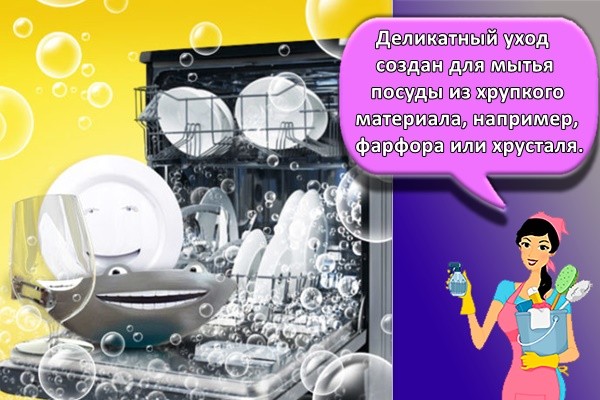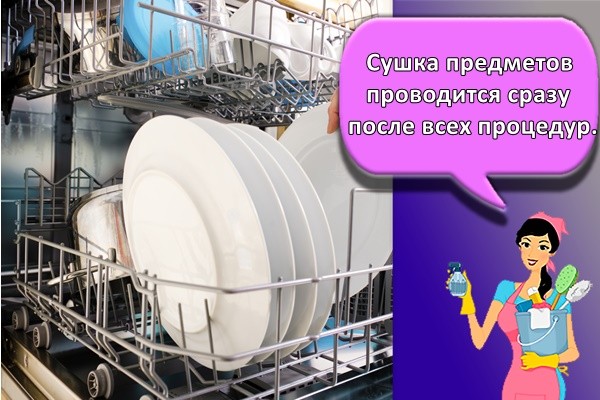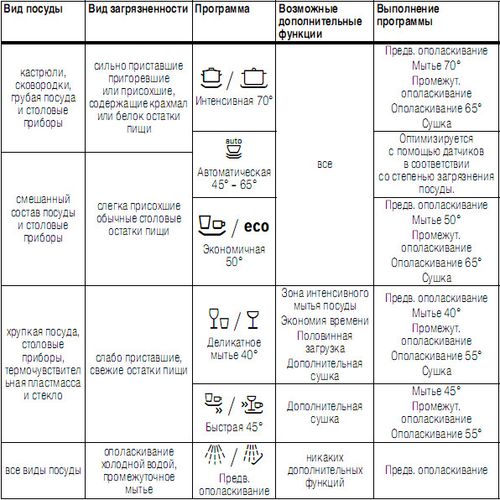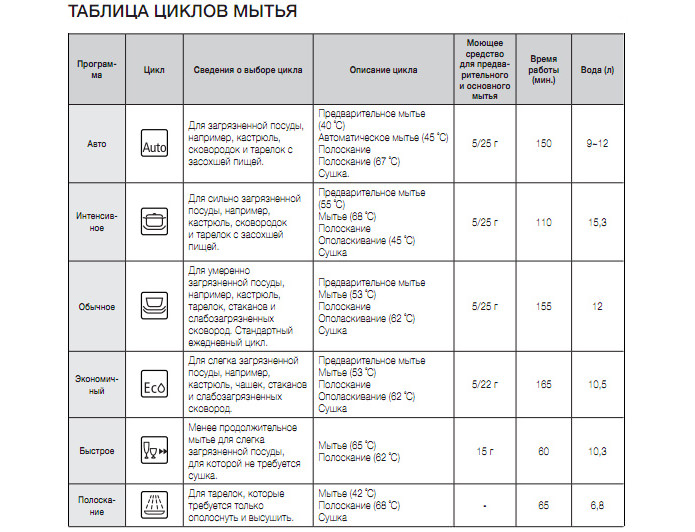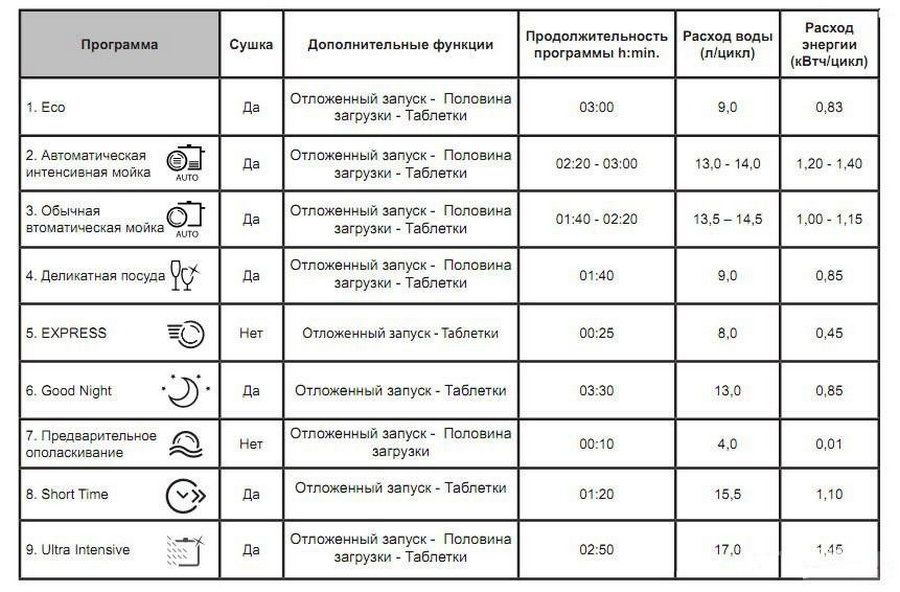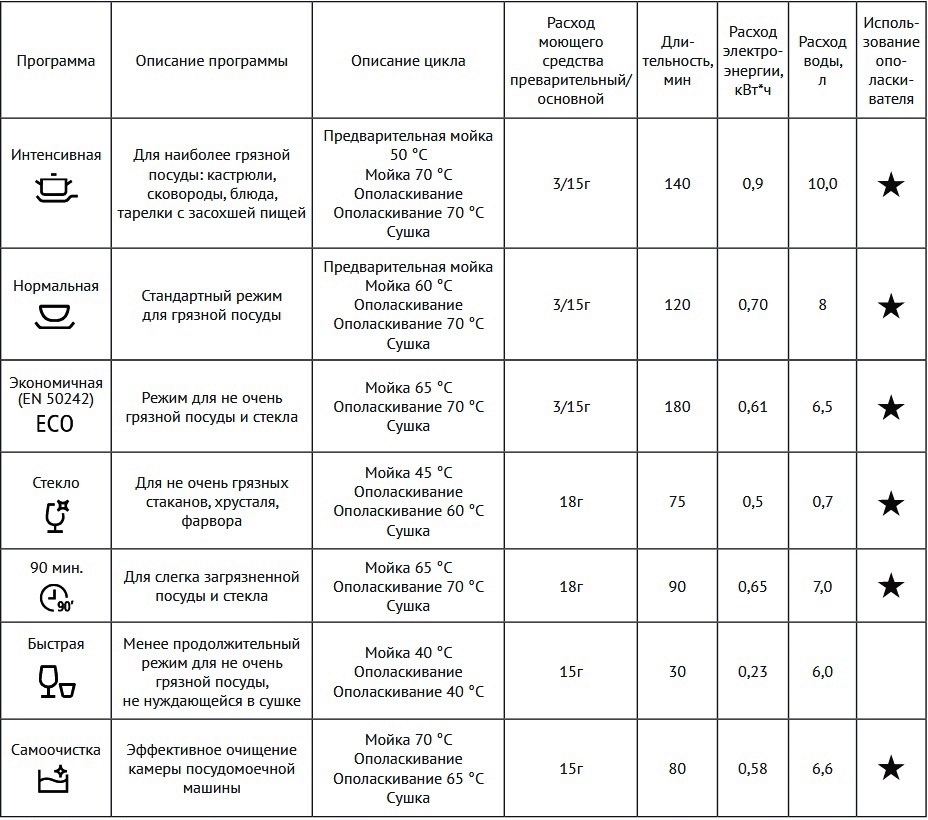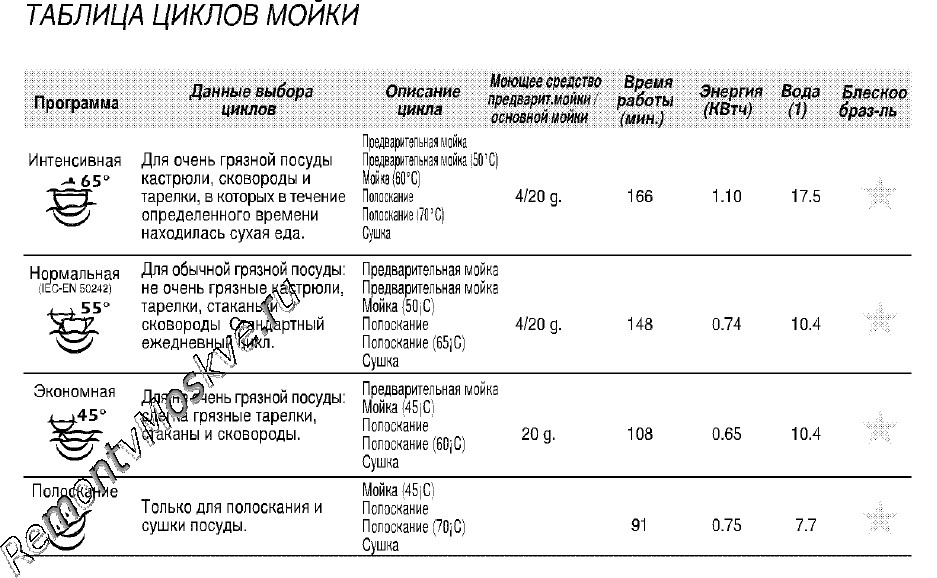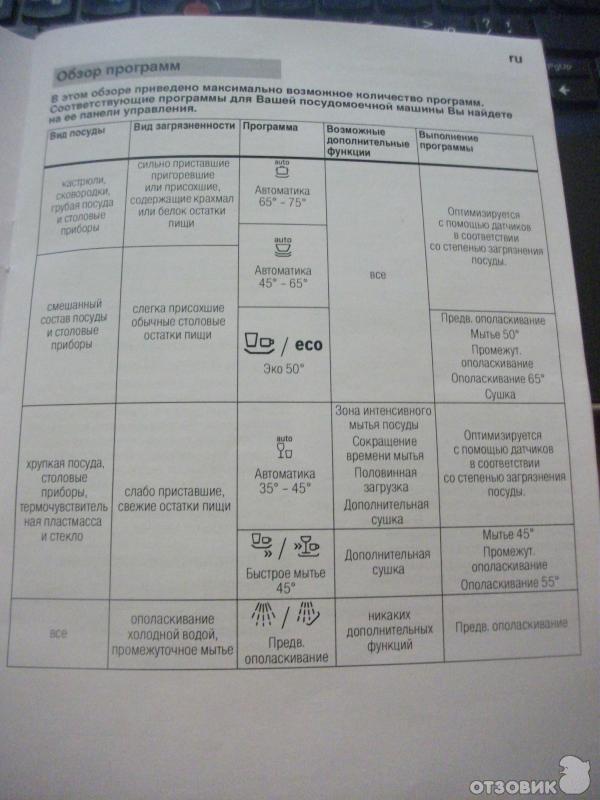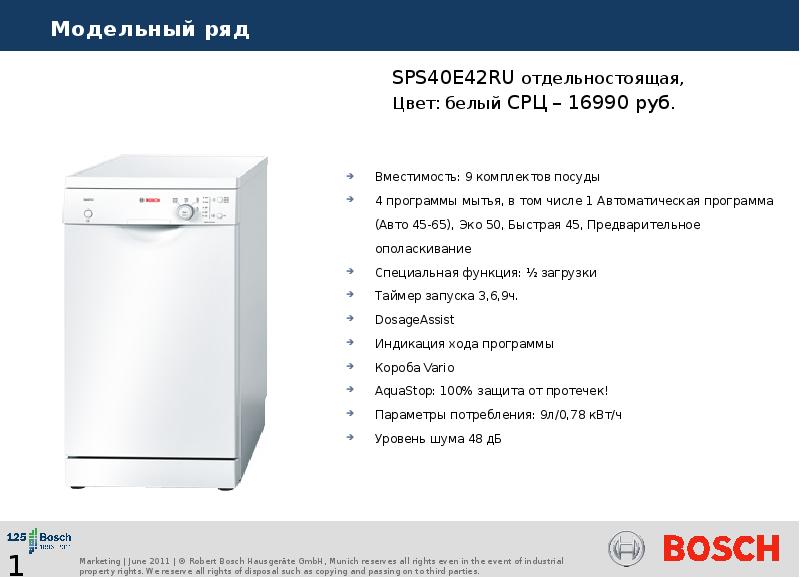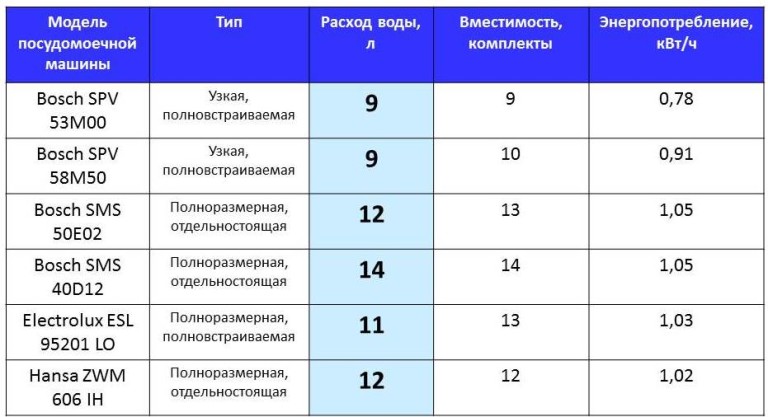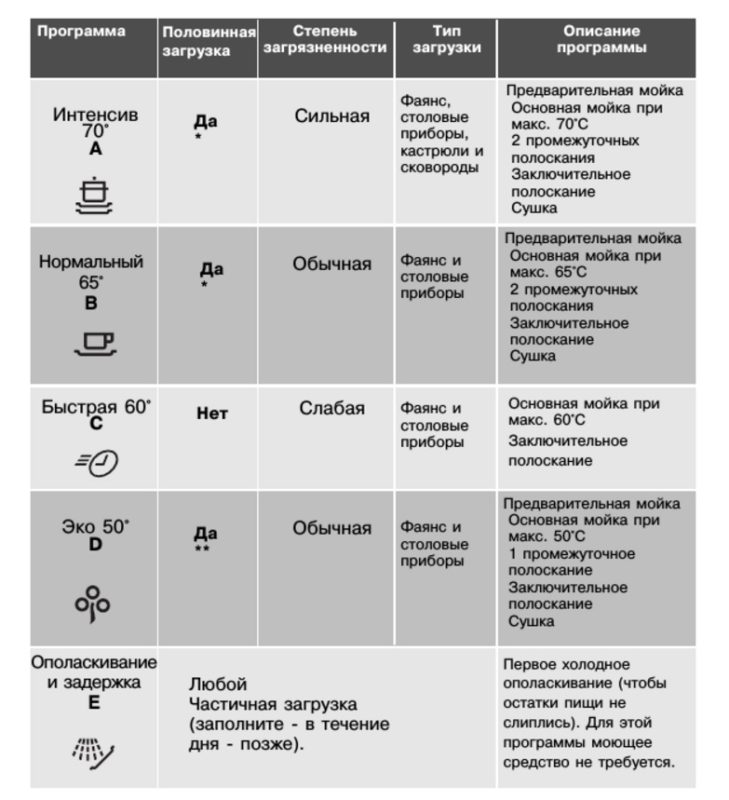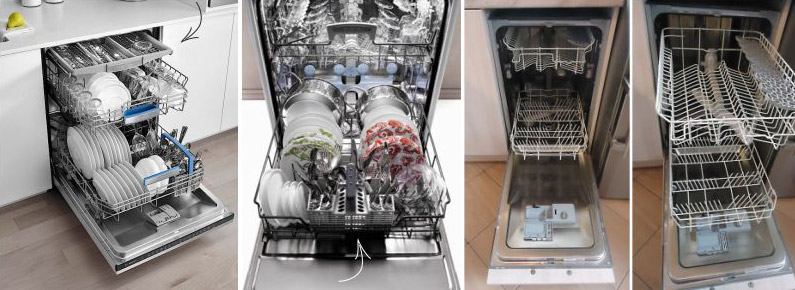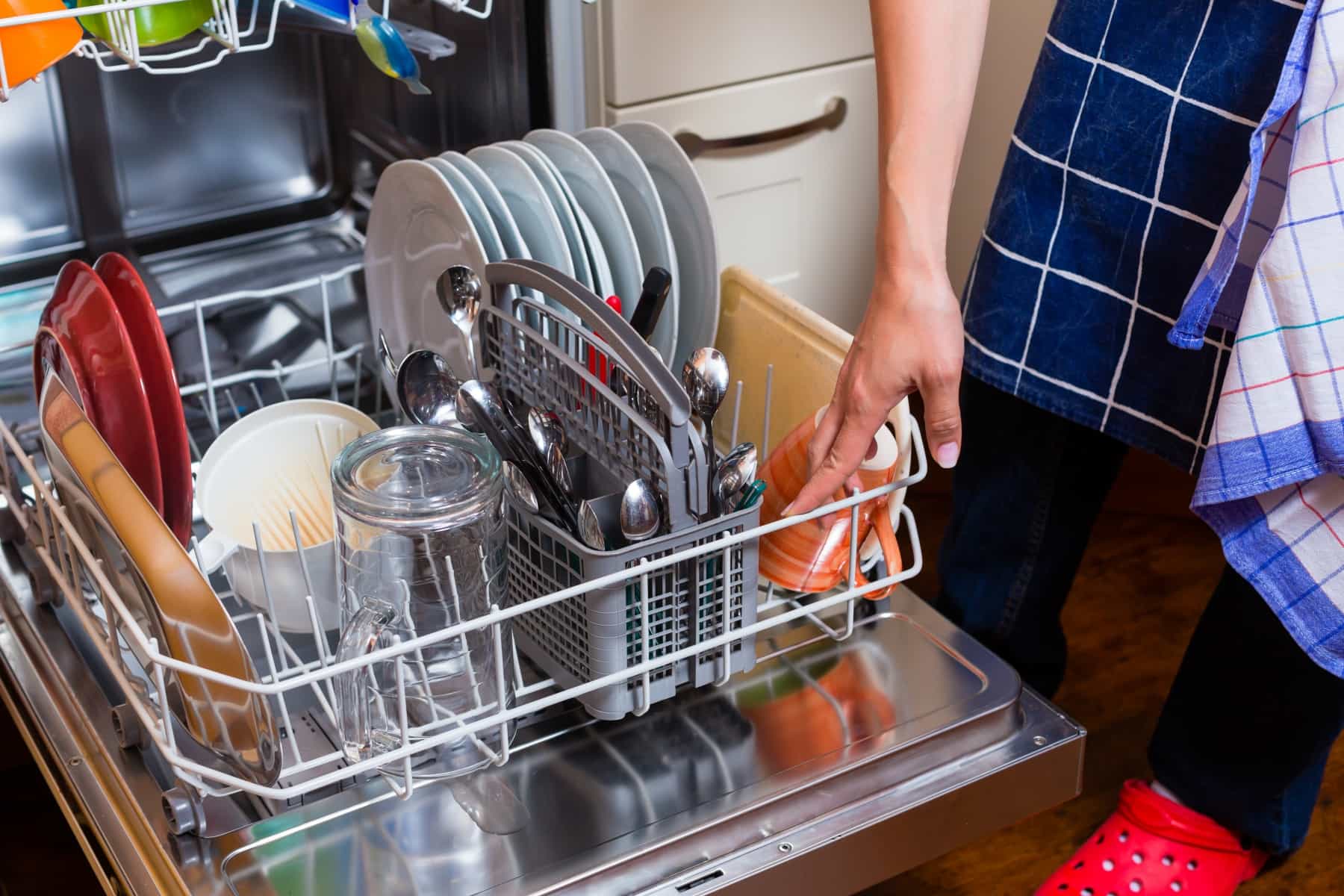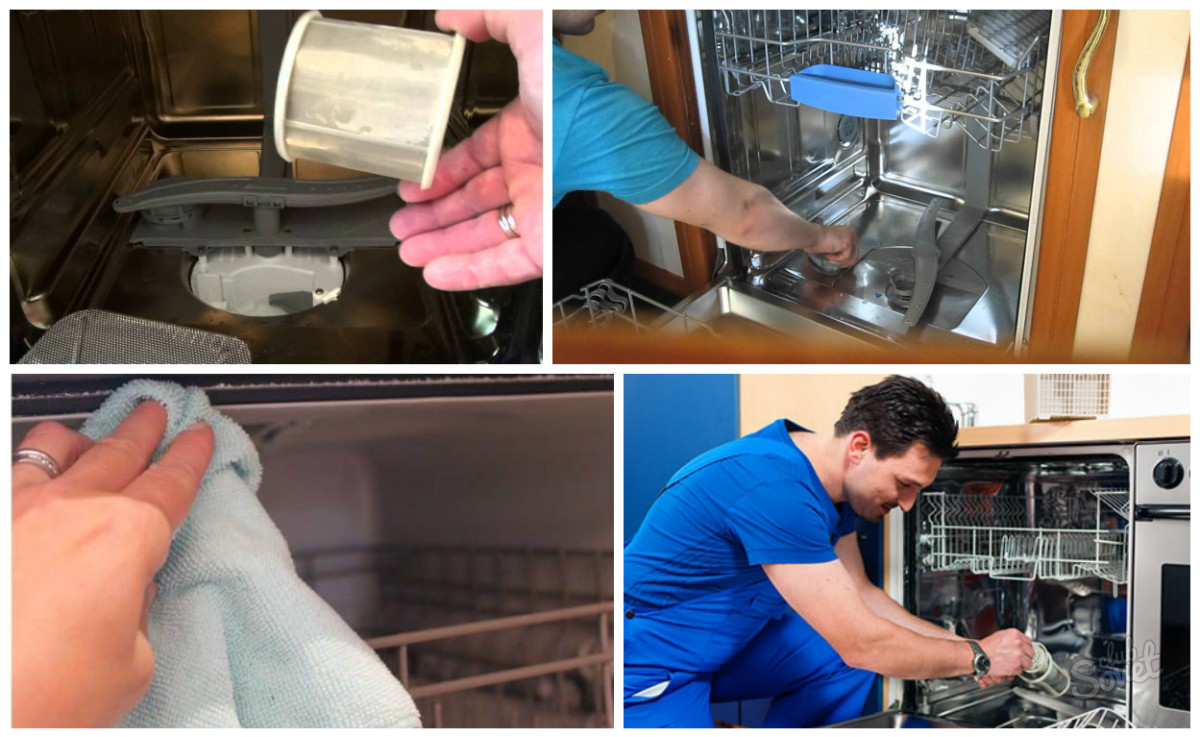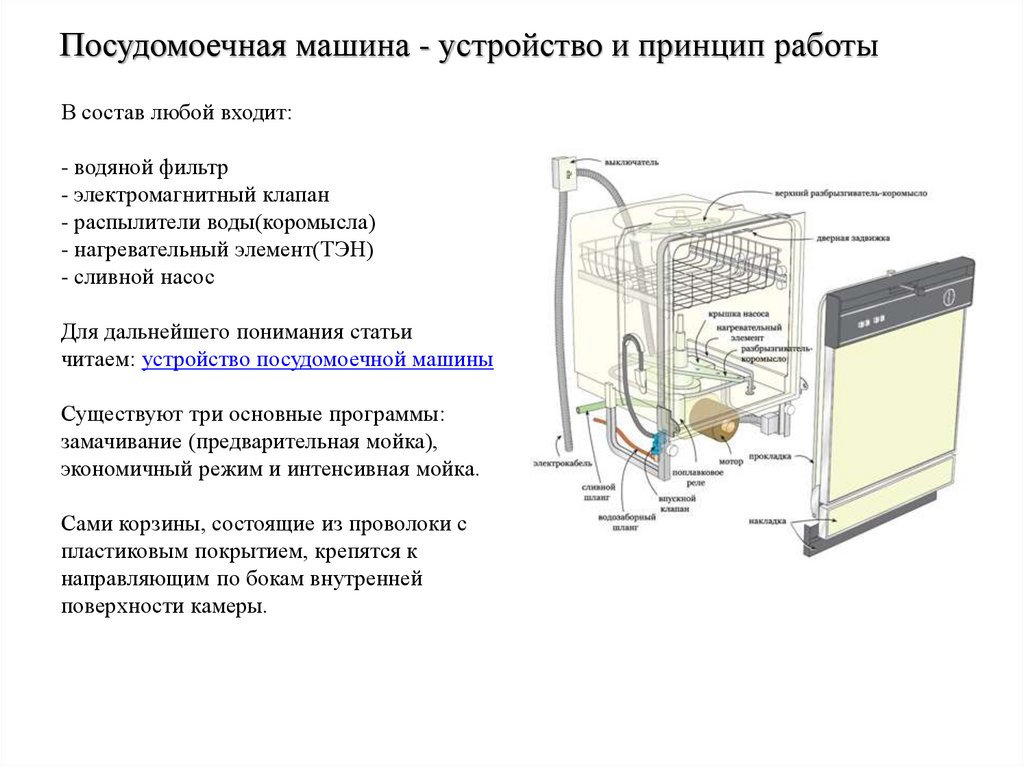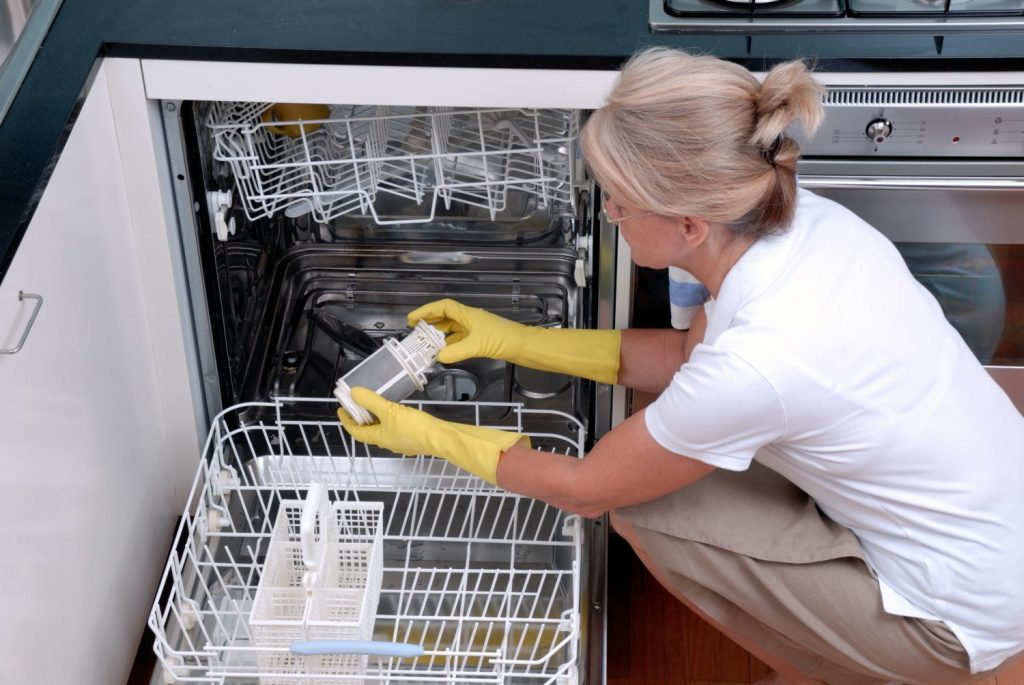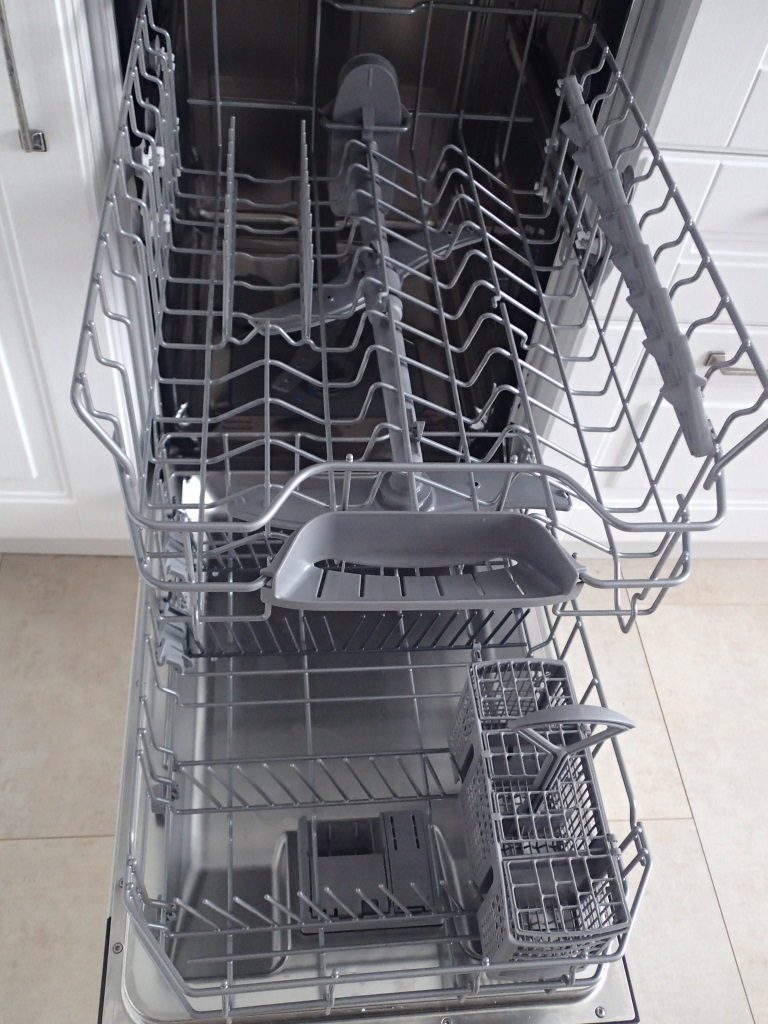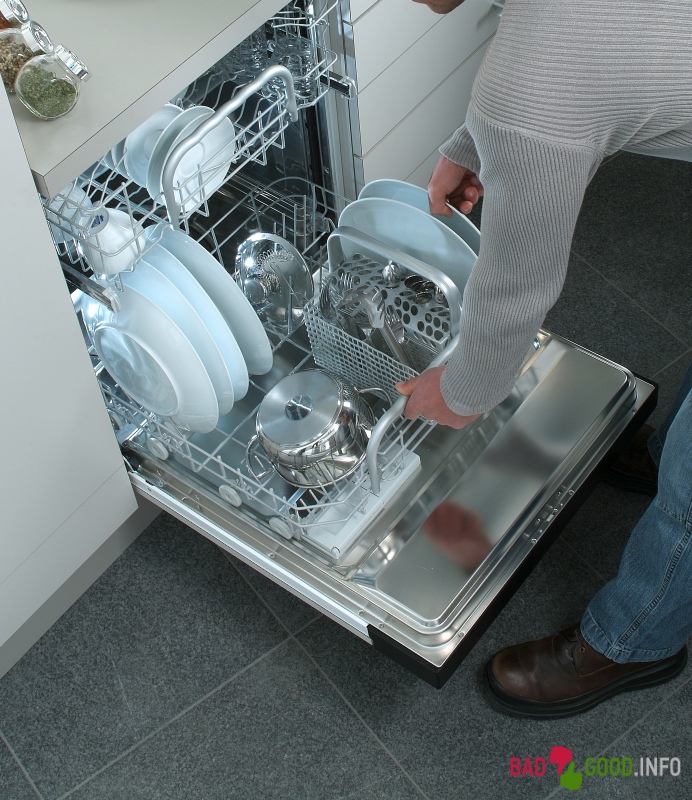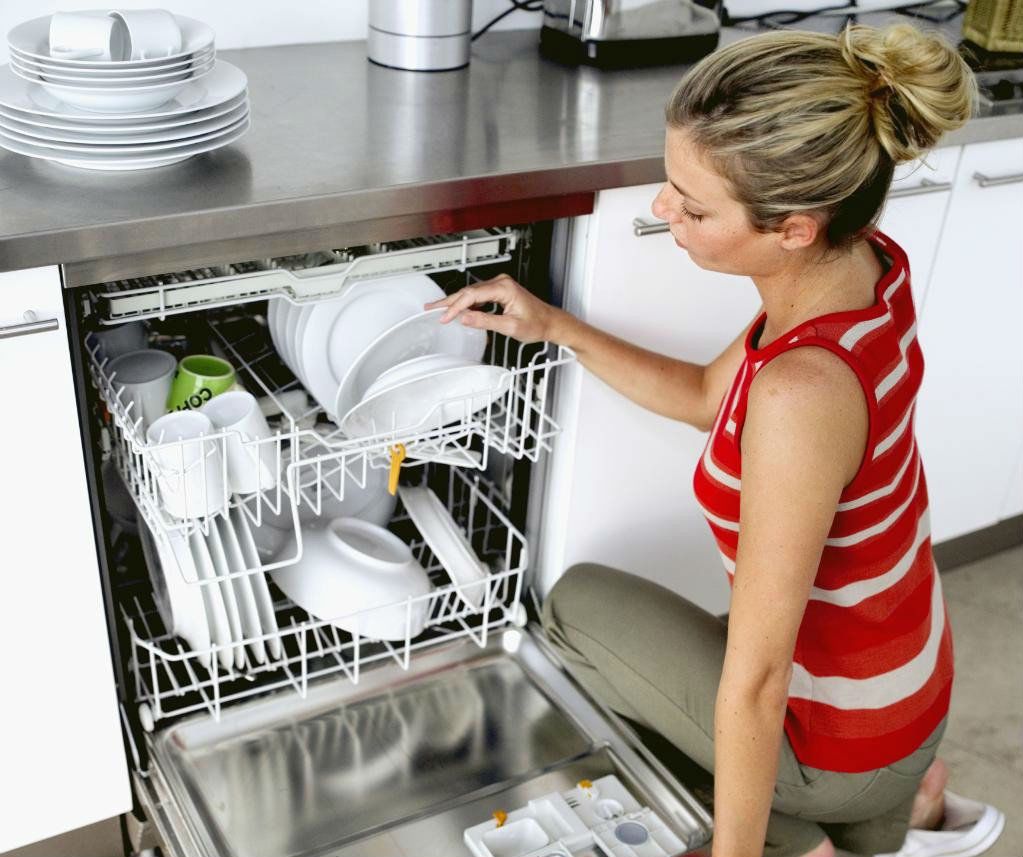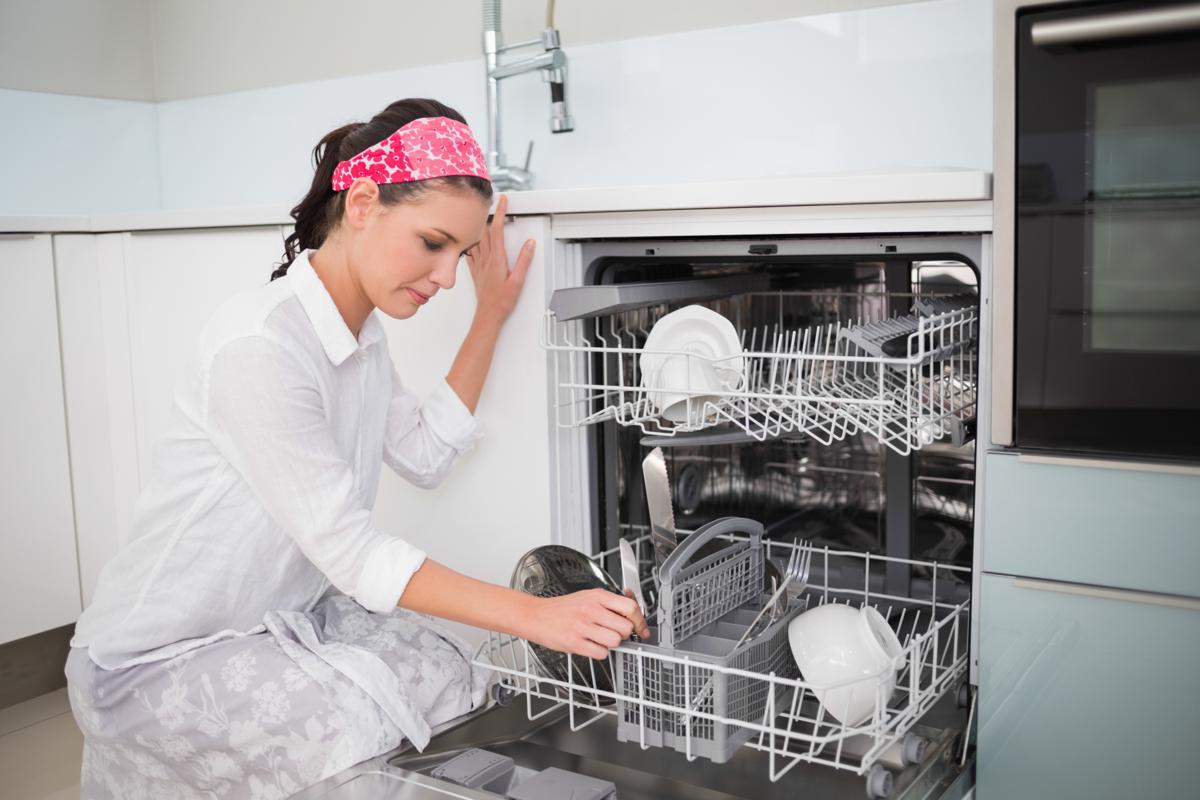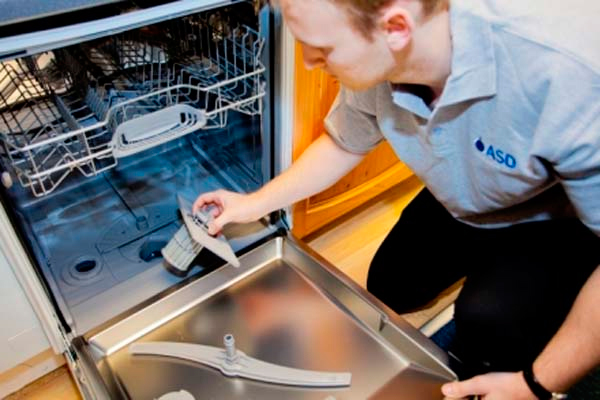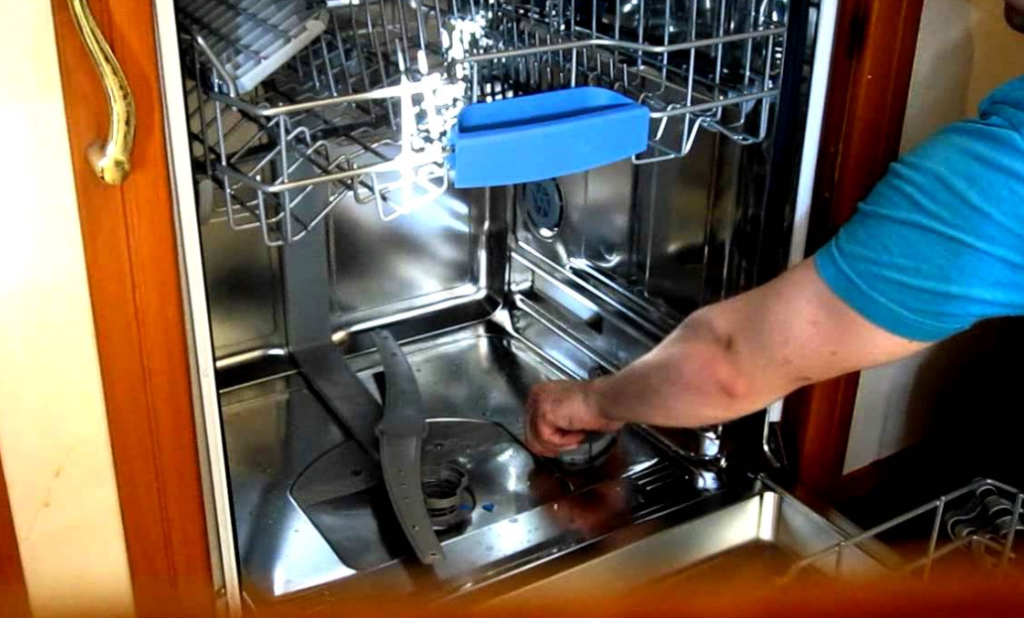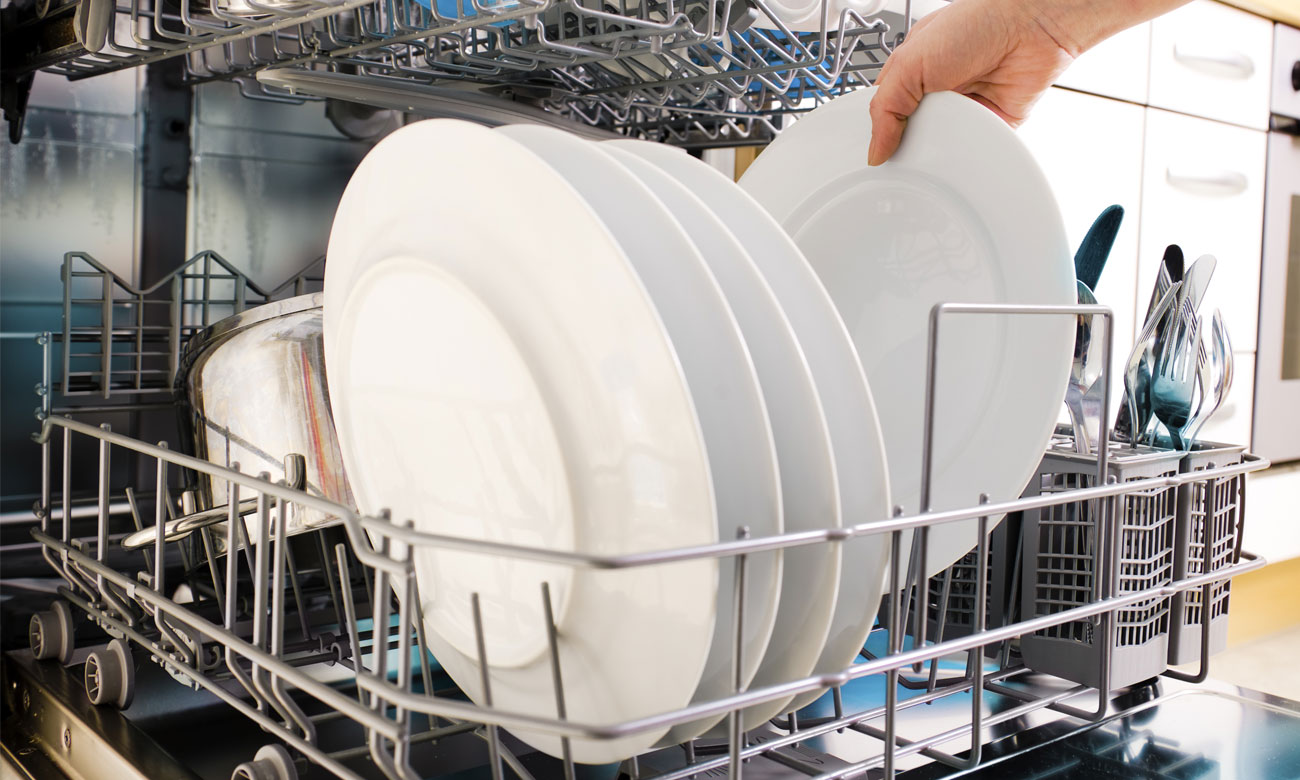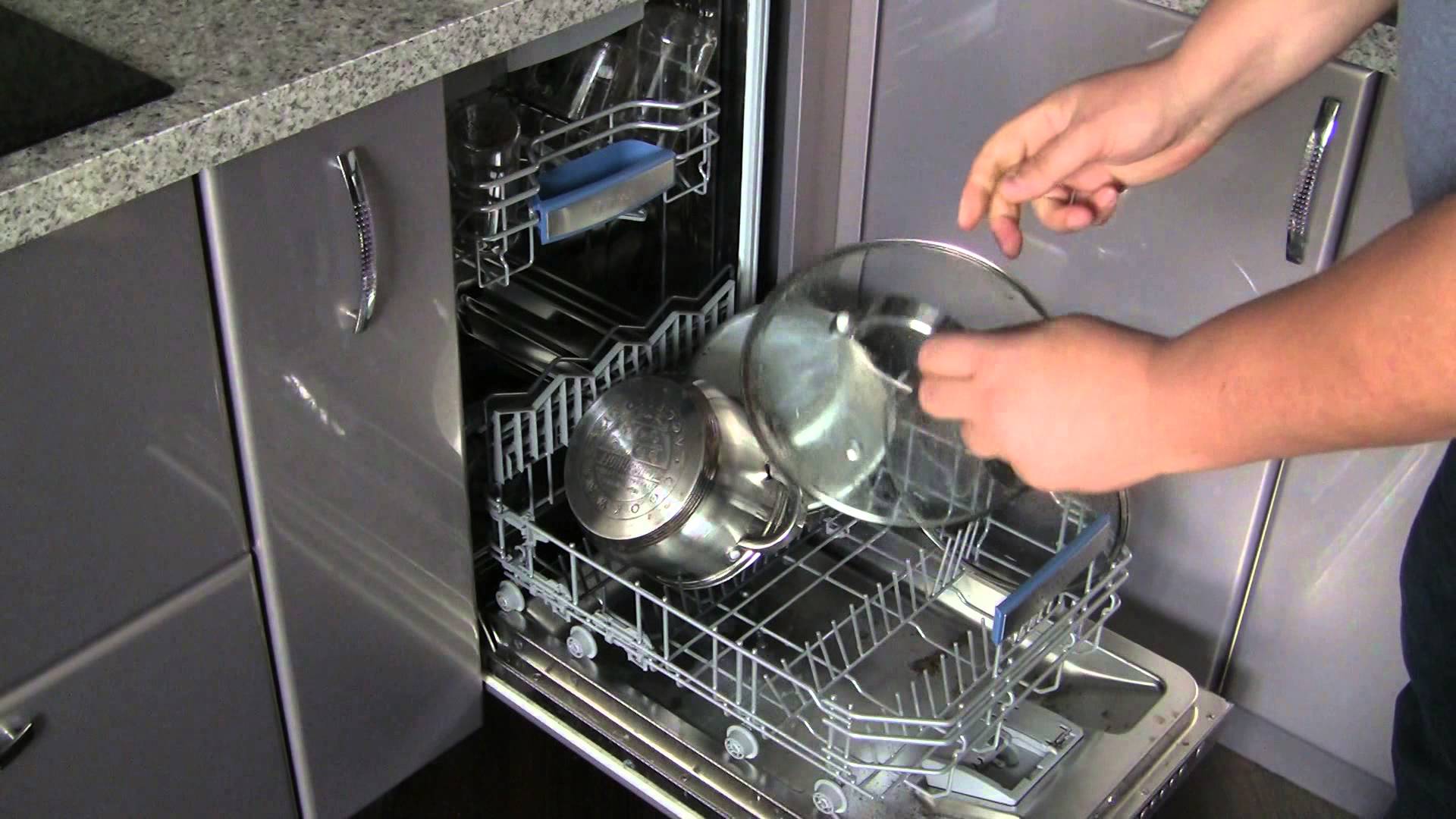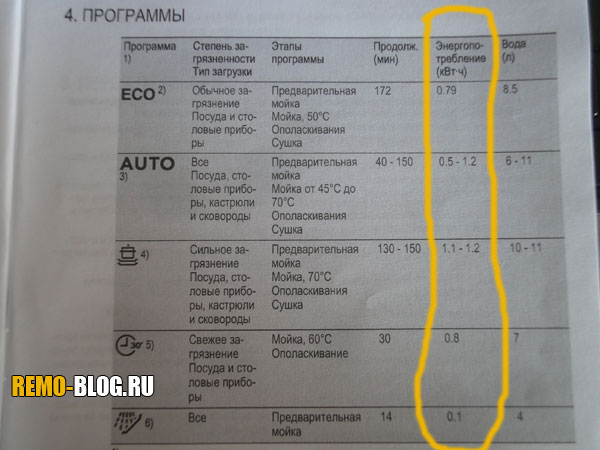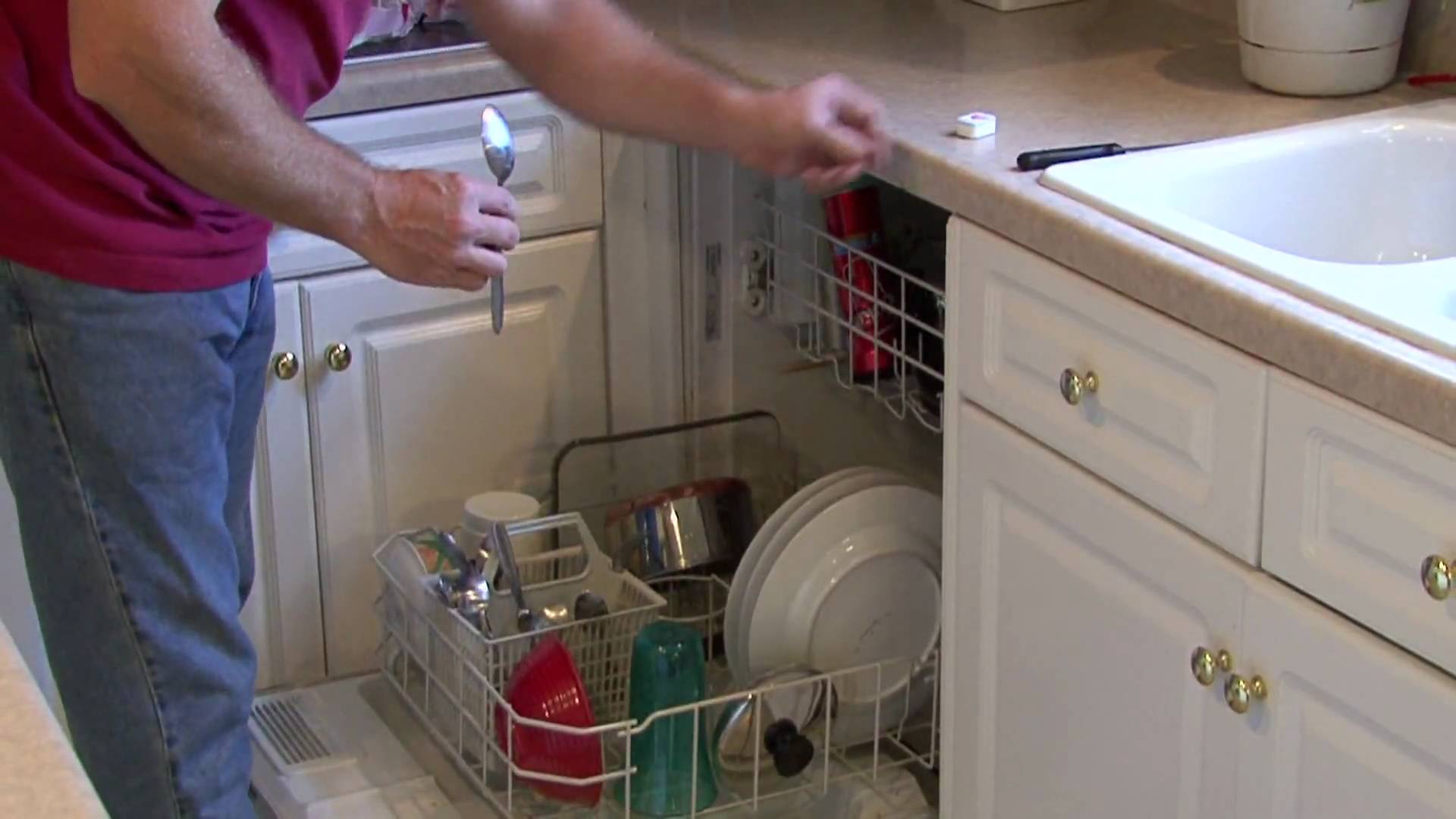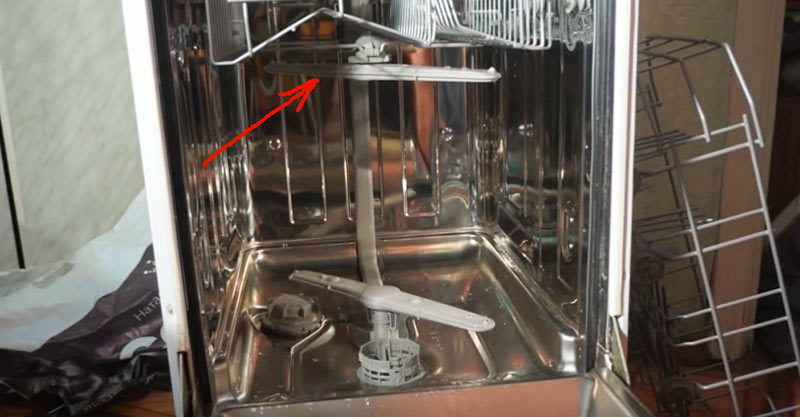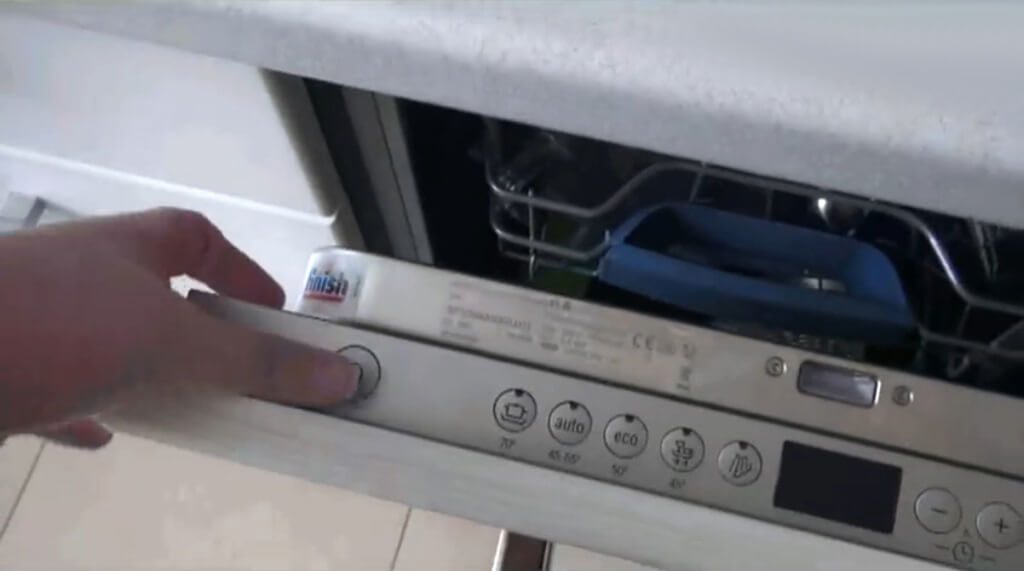Modes and their duration
Let's also talk about the modes that are most often found in dishwashers, and see how long each of them is calculated. Most dishwashers have 4 main washing programs:
- Fast wash - assumes that the machine washes the dishes at 35C, rinses them twice, which takes about 30 minutes.
- Normal Wash - Includes pre-rinse, 65C dishes, triple rinse and dry, this takes about 104 minutes.
- Economical washing - includes pre-rinsing, washing dishes at 50C, double rinsing and drying, the mode is designed for 155 minutes.
- Intensive wash - includes preliminary rinsing, washing dishes at 70C, four stages of rinsing and drying, the process takes 109 minutes.
Some dishwashers also have such programs:
- "Eat-Load-Run" - a mode that involves loading dishes immediately after a meal, the machine washes the dishes at 65C, rinses and dries them, completing all stages in just 30 minutes;
- Delicate - washing items at 45C, made of materials such as porcelain, crystal, glass;
- Car wash - this program recognizes the degree of soiling of dishes and automatically sets the required amount of water, powder and the duration of the wash cycle.
In addition, modern dishwashers, for example Bosch machines, have a Time Saving (Varlo Speed) function, which, depending on the selected mode, saves 20 to 50% of the time spent on washing dishes.
strong> However, as the washing time decreases, the energy consumption increases. Here you can choose whether it is more profitable to wash for about two hours for a long time with reduced energy consumption, or 1 hour, but spend more electricity.
Dishwasher models: duration of modes
Consider several different models of dishwashers of different brands and the duration of washing with these machines.
ELECTROLUX ESF 9451 LOW
- Quick wash - duration is 30 minutes.
- Intensive - lasts 65-75 minutes.
- The main one is 100-110 minutes.
- Economical - 120-130 minutes.
AEG OKO FAVORIT 5270i
- Quick wash - duration is 30 minutes.
- Intensive - lasts 100-110 minutes.
- The main one is 89-99 minutes.
- Bioprogram - 87-97 minutes.
HANSA ZWM 4677 IEH
- Quick wash - 40 minutes;
- Express 60 - 1 hour;
- Gentle wash - 110 minutes;
- ECO - 165 minutes;
- Normal - 155 minutes;
- Intensive - 130 minutes.
Gorenje GS52214W (X)
- Standard wash - 155 minutes;
- Intensive wash - 130 minutes;
- Delicate wash - 110 minutes;
- Economical wash - 165 minutes;
- Quick wash - 40 minutes;
- Hot rinse - 60 minutes;
- Cold rinse - 8 minutes.
So, in general, the duration of the dishwashing cycle in machines of different brands, for example Bosch, Siemens, Hansa, etc., practically does not differ. Exactly how much time the machine washes, see the display when choosing a program or in the instructions for the technique. No matter how long she soap, you can calmly go about your business at this time.
A couple of tips
The “half full” function of the appliance does not mean that in this case the use of this kitchen appliance with water and electricity will be at the optimal level. In most cases, the water consumption of a dishwasher is 60% of the usual amount. The same situation with electricity, in addition, overly soiled dishes may simply not be washed.
Systematic and sensible stacking of dishes will allow you to fill the dishwasher as much as possible. This will not only save water and electricity, but also provide perfectly clean dishes at the exit. Usually, any product comes with instructions with detailed pictures and recommendations on how to stack kitchen utensils.
It should be borne in mind that a bulky dishwasher is more profitable, based on the calculation of water consumption per full load. But she will use water according to the program, regardless of the amount of dirty dishes.
How does the water consumption depend on the washing modes?
The presence and use of additional modes affects the consumption of fluid.Thus, thanks to the "half load", costs are reduced by 20-30%. Also, savings are induced due to the function of "intelligent assessment" of the load: the device itself decides how much liquid is required for the cycle in order to wash the dishes efficiently and efficiently. These features are commonly found in premium models of all types - full-size, narrow, compact.
The set of functions and programs for each modification is determined by the manufacturer. The water consumption is influenced by the following regimes:
- Economy mode. Washing at 50 degrees. Consumption - 8-9 liters.
- Auto mode. Suitable for both tableware and pans. It includes preliminary washing, rinsing and drying. Consumption - 6-11 liters.
- Intensive wash. Costs rise to 10–11 liters.
- Weak pollution. Only 7 liters are spent.
How to repair a dishwasher (video)
Whatever malfunction you have to face, remember that making repairs with your own hands is possible only when you clearly know what exactly should be done in a particular situation. Otherwise, you still have to call professional repairmen, but it's not a fact that the final cost after your actions will remain the same.
Washing dishes in the machine is modern, practical and hygienic. Due to the higher temperature of the water and the special agents included in the tablets and powders, bacteria do not remain on the dishes. Finance question: use tablets or powder? The tablets are multifunctional, but they are more expensive. If funds do not allow, use detergent, rinse aid and salt.
Those of us who are the owners of such a magical au pair, like Dishwasher
sometimes face her whims. The reasons may vary. If the technique does not work, it is imperative to call the master. But there are problems that the hostess can handle herself perfectly. What could be the reasons for that?
A dishwasher is similar in many ways to a washing machine and the problems that arise with it are similar. The most serious ones are limescale on the heating element and blockage. In general, this device, when used correctly, is designed for 12 years
work.
If during the operation of the dishwasher, plugs are knocked out, plug into the same outlet an appliance of a similar power (kettle, for example). If the same happens to him, you need an electrician. If the problem is only with the dishwasher, the heating element probably burned out. Call the master.
Modes of operation
After loading all the dishes, you need to add detergent and rinse aid to the special compartments of the dishwasher. The washing program is selected.
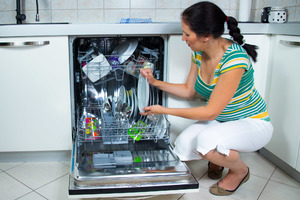 The basic modes for all types of these household appliances are basically the same. They can differ only in name. The standard set of programs is as follows:
The basic modes for all types of these household appliances are basically the same. They can differ only in name. The standard set of programs is as follows:
- Soaking or pre-washing must be switched on for heavily soiled objects, for example, with burnt food residues.
- High-intensity washing allows you to wash very dirty and greasy dishes without pre-soaking. Suitable only for heat-resistant cookware.
- Standard wash is the most common program that effectively cleans dishes with a moderate amount of water and energy.
- Economy mode consumes little energy and water. Recommended for lightly soiled items.
- The fast cycle washes dishes quickly, but does not dry. This mode will not cope with heavily soiled dishes.
- A delicate sink is used for glass and crystal products.
How long does it take for a car to wash properly?
The duration of this process depends on several factors, but the main thing is the washing mode that you choose. Machine washing of dishes is not much different from manual washing, and it consists of several usual stages. It often starts with soaking if the dishes are too dirty or if you are trying to wash off the remnants of fat or burnt food. This is followed by direct washing and rinsing, and this cycle ends with drying.Each of these stages takes its own time, which also depends on the mode that you have chosen. In addition, the temperature, which is necessary for washing according to a particular program, plays an important role: the higher it is, the longer the washing process itself will take.
As a rule, one stage of operation of a Bosch dishwasher, as well as devices of many other manufacturers, takes from fifteen minutes to half an hour. Different machines may differ not only in their size and functionality, but also in washing modes. Today, the work of many manufacturers is aimed at making such units for your kitchen that would cope with a large amount of dishes not only as efficiently as possible, but also quickly enough. If we compare at the same time about ten models of dishwashers from different manufacturers, then the average washing time will be about half an hour.
Water consumption
One of the main questions of the consumer is how much water is consumed by the dishwasher per cycle, are there really any savings?
In the machine, the water is not drained until the end of the work, it only passes through special filters, and clean again is supplied upstairs to rinse the dishes. Additional savings are also generated due to the fact that washing takes place with the help of sprinklers, that is, the dishes are not washed with a jet, as in manual washing, but with fine sprays. It is possible to reduce water consumption by 20-30% by choosing economical operating modes. It should be noted that the size of the device does not play a special role.
Pay attention to the level of economy before buying, as a rule, it is indicated by letters:
- A, B, C - dishwashers that consume from 9 to 16 liters are called highly economical machines;
- D, E - machines that use water in a volume of up to 20 liters are of the average economic category;
- F, G - dishwashers that consume up to 26 liters of water per cycle are low-efficient.
Class A dishwashers not only save water, but are also leaders in the lowest energy consumption.
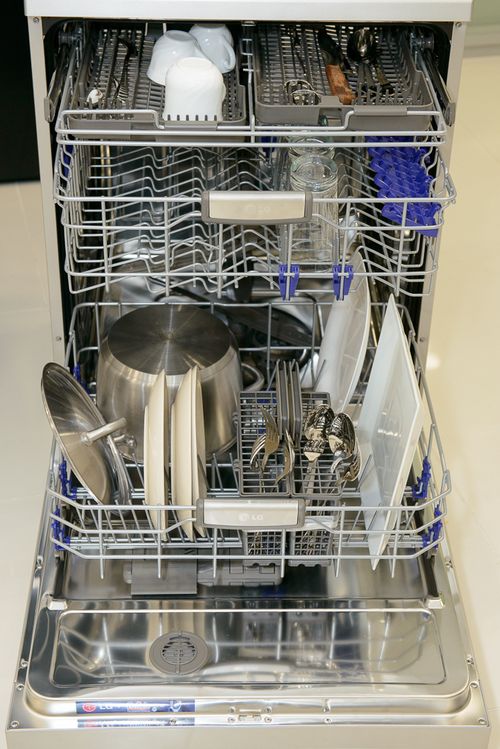
What to look for when buying?
Before buying, you should know how many dishes you plan to put in the machine, pay attention to the number of baskets for this. The dimensions and type of dishwasher depend on the intended place of installation, one buyer prefers built-in appliances, the other is a desktop option
Note how quiet the dishwasher cycle is. The control panel should be clear and user-friendly
It is better to abandon complex techniques if you cannot make out most of the buttons.
The control panel should be clear and user-friendly. It's better to skip the complicated technique if you can't make out most of the buttons.
Entrust the installation and connection of the dishwasher to professionals, this will give you an additional guarantee and confidence in the correct operation of the machine. Ask them to run the machine once in front of you to verify that the equipment is working.
Water saving and other benefits
In addition to significant savings in water resources, modern dishwashers have a lot of other advantages. Firstly, the quality of dishwasher washing is incomparable with the manual method of impact on dirty dishes. This is influenced by special detergents, as well as by the high temperature of the water. After all, an ordinary person will not wash dishes at 75 degrees in a liquid environment. Secondly, it is calculated that a dishwasher saves the owner time in a year, comparable to the monthly stay of an employee at work.
Such kitchen equipment can be successfully used not only for washing dishes. All kinds of gas burners, barbecue grills and even refrigerator shelves, many owners of modern technology manage to wash in the dishwasher. And only our people could think of effectively using dishwashers for washing potatoes and other vegetables, even rubber boots are used.
Four basic washing programs
The washing and drying cycles are between 0.5 and 2.5 hours.During this time, several sets of cutlery will be washed. They can also be used to wash pots and pans. True, you will have to spend your time cleaning the dishes from large food debris, but at the same time, the rest of the time that would have to be spent on washing the plates will be freed. The duration of the dishwasher cycle depends on the set program in which the following can be included:
- preliminary soaking of dirty dishes;
- direct washing;
- rinsing with or without conditioner;
- drying.
The cycle, in which the dishes are washed directly, lasts on average from 15 to 25 minutes, rinsing continues for the same amount. Finally, with the set program, the machine dries up the washed dishes. It takes about 20 minutes more.
Often, machines have 4 washing modes, that is, 4 programs:
- Quick wash - no preliminary wash, program time - 30 minutes. In some models, this mode is called rinse.
- 70 degree mode - long mode - 2 hours 20 minutes, short mode - (Bosch machines have a Time Saving (Vario Speed) function - 1 hour 30 minutes.
- Eco 50 degrees is the most optimal mode, long mode - 2 hours, short mode (Vario Speed) - 1 hour 20 minutes.
- Auto - 45-65 degrees - 2 hours 40 minutes.

Bosch dishwasher programs.
The fastest program has a low temperature (about 35 degrees). Its duration does not exceed 30 minutes. A typical wash takes 1.5 hours and the water heats up to 65 degrees. During this time, the triple rinse and dry operation is activated.
The economical program consists of pre-soaking the cutlery, rinsing at 50 degrees, rinsing with a double change of water and finally drying the dishes. It will take longer to finish this program - about 2.5 hours.

Duration of the program (washing) using the example of the Hotpoint-Ariston LTF 11M121 dishwasher.
For the most dirty dishes, use the automatic intensive wash. In this case, the dishes are soaked and then washed at 70 degrees. After that, rinsing takes place four times, and at the end of the mode, the dishes are dried. The duration of such a program is slightly more than 2.5 hours.
Some cars, for example, from bosch, have other modes:
- Quick wash immediately after meals. The duration of the regime is 30 minutes.
- Delicate washing of cutlery made of crystal, porcelain or glass at a temperature of 45 degrees.
- Automatic washing, in which the machine itself determines the degree of soiling of dishes, calculates the consumption of water, powder, and also programs the cycle duration.
- The time-saving function cuts it in half, however, this increases energy consumption.
- Express mode assumes an incomplete load of the machine, in which drying is not provided. The whole washing process takes 15-20 minutes.
- For example: at 65 degrees in a Bosch SPS 40E42, drying and washing takes exactly 1.5 hours.
The presence of a dishwasher is especially important after festivities and large feasts. The hostess will not have to wash dirty dishes until late at night. All you need to do is load the cutlery onto the shelves of the machine and in the morning remove them clean and shiny, including pots, pans and baking trays.
5 problems and their solutions
Rainbow film
Are you confused by the rainbow film on glasses and salad bowls? Most likely, its appearance is caused by the fact that the water is too soft, and the washing mode takes place at a very high temperature. Try to select a shorter program and set the water temperature lower.
Colored spots
Sometimes, after washing, colored spots remain on white dishes made of food-grade plastic: orange, yellow, pink. Or, before washing, there were colored vegetables (such as beets) on the plates, and they colored the plates. If the plastic dishes turned black, there was silver nearby. In both cases, experts advise choosing a mode with a high washing temperature.And be sure to read the instructions for the dishes: some are not dishwasher safe.
Dirty dishes
Are there food residues on the plates after washing?
Chances are, you have placed oversized dishes in the basket incorrectly, and they are blocking the spinning arm that splashes water.
The reason may be a clogged water spray (the same rocker arm). Make sure the water nozzles are not clogged. If there is a blockage, an ordinary toothpick will help.
Another possible reason is that the machine is overloaded and the dishes are touching each other.
Or the filter located on the bottom of the machine is clogged. Get it out and clean it out. It is recommended to rinse the filter with hot water weekly.
If the problem persists, then, alas, you cannot do without calling a specialist.
If you often eat semi-finished products at home, then such food contains fats that are deposited in a machine that operates in economy mode at a temperature of 50C. Therefore, every 4th start of the dishwasher must be at a temperature not lower than 60C
Cloudy glass
Are glasses, glasses and salad bowls covered with a cloudy whitish coating after the end of the washing cycle? There may be three reasons.
Or the glass from which the dishes are made is of poor quality. If the cloudy coating is not removed with vinegar, it means that the glass is corroded. You should not use such dishes.
Or the reason is in the rinse aid, or rather in its incorrect dosage. A rinse aid is a surfactant (surfactant) that makes it easier for the water to drain off the dishes. If it is not enough, the surface of the washed and dried dishes will be in water streaks, and if there is too much of it, the glass will be whitish.
There may be little salt in the machine to soften the water, especially if it is hard. Adjust the salt supply according to the instructions for your dishwasher.
Rust
Did you find traces of rust on the washed dishes? Most likely, the corrosion of the dishwasher parts is caused by the regenerating salt, for which there is a special container. Perhaps it was not closed tightly, or salt accidentally got to the bottom of the car - and this is the result.
If you accidentally spill salt, run the empty car in the “pre-wash” program in cold water.
Crumple a small ball out of aluminum foil and place in a cutlery basket.
Factors that affect the duration of the wash
The dishwasher procedure repeats the same steps as for manual cleaning. If the dishes are too dirty, then pre-soaking is required. This is followed by the main stage, rinsing and drying. Each stage of work lasts a certain time in accordance with the selected washing program. The higher the water temperature, the longer it will take to wash the dishes. As a result, a full cycle of washing dishes in a typewriter lasts from 32 minutes to two hours.
Soak
If the dishes are very dirty, stubborn stains and dried pieces of food are present, it is better to use the soak program. The duration of the procedure is 16-19 minutes.
the washing up
Immediately after soaking (if this function was originally set), the dishwashing process begins. It assumes the following scheme of work:
- As soon as the household appliance has taken the required amount of water, it begins to heat up to the temperature of the set function. The washing process begins.
- The machine then uses detergent.
- After these actions, water and detergent enters the spray nozzles located at the top and bottom of the device.
- The sprays rotate at high speed and, under pressure, deliver hot water to the contaminated cutlery that is placed on the shelves.
- After the main stage of washing, the dirty water is drained into the sewer, the next stage begins - rinsing.
On average, a wash cycle lasts 17-24 minutes. If the heater is out of order, the machine may not start.
Rinsing
This cycle is necessary in order to get rid of the remains of the detergent powder. The cleaning agent can harm human health.The rinsing process takes 18 minutes. Rinse aid is used instead of detergent, the water does not heat up.
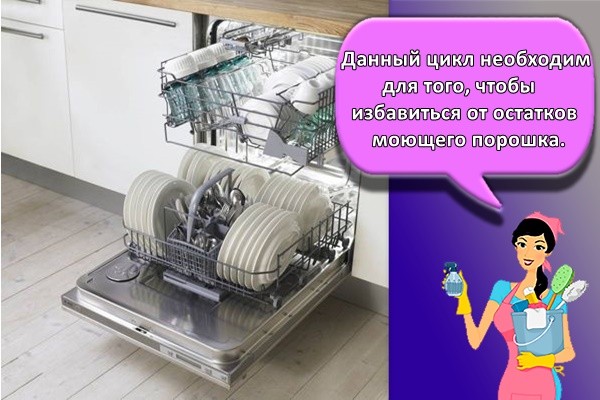
Drying
Many dishwashers have a drying program. It takes 16-19 minutes for the items to dry thoroughly. In cheaper models of dishwashers, a conditional type of drying is assumed. Expensive models are equipped with a turbo dryer. Hot air is blown over wet objects.
Dishwasher breakage and blockages
If stains on the dishes after the dishwasher have become a constant occurrence, then most likely you need to clean them. Yes, yes, like any other household appliances, the dishwasher can get dirty and work worse from this. In any washing unit, regardless of type and model, there are several places worth visiting regularly:
- mesh filter for food residues;
- bulk filter;
- sprinklers;
- Heating element and tank.
First of all, follow the instructions for use and find a filter in your dishwasher to catch food particles. If the dishwasher does not wash well, it is most likely dirty. Usually the filter is located at the bottom of the unit and is a fine mesh. It should be cleaned and washed at least once every 10 days.
If in your apartment not too clean and soft water flows from the pipes, then be sure to regularly change the core of the coarse filter, which is located at the entrance to the dishwasher. If this filter is clogged, then the water pressure entering the unit will be significantly weakened. Weak water pressure is another reason why the machine does not wash dishes well and deposits remain on it.
Nozzles, heating elements and the tank of your assistant may suffer from the presence of limescale, in other words, scale. To prevent this from happening, purchase a descaler for your type of dishwasher. Run it in idle mode at least once a month. Use a product that dissolves and removes limescale.
If you notice that the dishwasher does not wash the dishes well, take a closer look - the reason may lie in the use of low-quality powder or other detergent. If you recently changed your detergent and began to notice plaque and stains on mugs and plates, do not hesitate, this is precisely the reason. Fixing the problem is easy - buy the right product and your dishwasher will clean better.
If you are using the same product as before, and the machine has begun to wash the dishes worse, then perhaps the matter is different:
- a gray coating is visible on seemingly clean dishes and stains have appeared - there is clearly not enough rinse aid in the water, you need to adjust its consumption;
- the machine washes traces of tea, coffee and lipstick inadequately - the detergent contains little bleach; to improve the result, purchase the appropriate additives or change the detergent;
- for some reason, white streaks remain on the pots - the salt lid is not closed tightly; salt powder gets inside the machine and a white coating is obtained;
- plastic dishes remain greasy - there is not enough fat-dissolving substance; change detergent or add additives manually.
If your dishwasher starts to leave greasy deposits and streaks on the dishes, remember the last time you used special salt. The reason may lie in the fact that, due to excessively hard water, the ion exchanger failed and the detergents began to dissolve poorly in the liquid. Reapply salt and the dishwasher will work better over time.
Method 2 - manual dishwashing
- Washing mode - as economical as possible, when soaping it turned off the water,
- Duration of washing - 21 minutes,
- Water temperature - comfortable warm, closer to hot,
- Quantity - about 2/3 of the capacity of the dishwasher, dirty dishes after dinner and breakfast.
- List of dishes (34 units) - 9 plates, 7 cups, 1 saucepan, 2 salad bowls, 1 cutting board, 1 teapot, 13 cutlery.
Counter readings
| Before washing starts | After the end of the wash | Water consumption |
| h / v - 41.937 h / v - 79.600 | h / v - 41.960 h / v - 79.620 | g / in - 23 liters / in - 20 liters |
The total water consumption is 43 liters.
Thus, we see that the dishwasher uses water three times more economically. At the same time, the dishwasher does not use hot water, which is much more expensive than cold water.
We can assume that when washing dishes once a day during the year, we get the following indicators:
Dishwasher: 14 liters x 360 days = 5,040 liters, including 5,040 liters of cold water.
Hand wash: 43 liters x 360 days = 15,480 liters, including 7,200 liters of cold water and 8,280 liters of hot water.
For residents of Moscow 1 cubic meter. meter (1,000 liters) of cold water in 2012 cost 26.75 rubles, and for hot water from 93.38 rubles. In 2013, of course, water tariffs increased, but let's calculate the costs at last year's prices:
Dishwasher: 5,040cc meter x 26.75 rubles = 134.82 rubles.
Hand wash: 7.2 cu. meter x 26.75 rubles + 8.28 cubic meters. meter x 93.38 rubles = 965.79 rubles.
In large families, especially in which children or adolescents wash the dishes for an hour and are not accustomed to saving water, the water consumption can be ten times higher than that given in this experiment. In the experiment, hand washing takes only 21 minutes a day, which is very rare.
If the hostess washes the dishes with her hands several times a day and does not turn off the water during the washing process, then the water consumption per day is at least 100 liters. In this case, the calculations will be as follows:
Hand wash: 100 liters x 360 days = 36,000 liters, including 18,000 liters of cold water and 18,000 liters of hot water.
18 cubic meters meter x 26.75 rubles + 18 cubic meters. meter x 93.38 rubles = 2 162.34 rubles.
The cost of water in the dishwasher remains unchanged - 134.82 rubles.
With wasteful use of water during manual washing, the water consumption is 15 times higher than the dishwasher.
Washing nuances
Many consumers are wondering why there are significant water savings when using a dishwasher? The main reason is that modern devices use a special technology in the process of washing kitchen utensils. The volume of water already drawn from the plumbing system is used by dishwashers several times. The liquid solves the following tasks:
- It is used for pre-spraying.
- Washing with special detergents.
- Rinsing.
After completing one operation, smart technology does not dump water into the sewer, but passes it through filters and uses it in the next production cycle. In the process of washing dirty dishes, the liquid is partially drained, and a fresh portion of water comes from the water supply. Thin water jets are thrown out of the sprinklers under strong pressure, which also contributes to significant water savings.
On average, a complete washing and drying cycle of kitchen utensils takes about 2 hours. But if you take into account that a decent amount of dishes is washed with this water consumption, moreover, when using 4 - 5 sets, you can wash several pots and pans, which is also a significant plus. An experienced hostess can handle such a volume in just 30 minutes. On the other hand, even our time is worth a lot of rest. However, you still have to spend some time cleaning dirty dishes from solid or adhering food debris. But in comparison with manual washing, it is insignificant.
Product use
Of course, for bachelors, the purchase of a miracle of equipment may not be such an urgent issue, because there are a lot of tips on the Internet, up to putting a disposable plastic bag on a plate. But for even a small family, the acquisition of such a product is a real way out. In addition, a modern dishwasher can significantly save money on the use of water resources.
Consumption
What is the approximate consumption of a dishwasher? Of course, it will differ slightly depending on the brand, model and year of manufacture. But even outdated dishwasher models are unlikely to be able to consume more than 20 liters of water. Almost all manufacturers indicate in the technical characteristics of the product the main parameters of water consumption by washing equipment. It is subdivided, depending on the size, into full-size and narrow. These purchase criteria show how many dishes a particular machine can hold, and how many items it can wash efficiently in one wash.
13 - 14 common cookware sets are capable of shining a full-sized product. The maximum water consumption will not exceed 15 liters. Compact size (narrow) machines capable of processing 6 to 9 sets. At the same time, the equipment will take no more than 10 liters of water from the water supply system.
Saving
Still, does the dishwasher save our water? According to experiments and consumer reviews, when manually washing dishes in an amount corresponding to 1 dishwasher load, hot water consumption reaches about 70 liters, and cold water consumes about 30 liters. It turns out that modern household washing equipment can significantly reduce the meter readings of water supply networks.
So how much water does the dishwasher use? Let's give an example:
Bosch SPV63M50 (compact) - loading up to 9 sets, consumption 8 l;
Siemens SN66M094 (normal) - loading up to 14 sets, flow rate 10 l;
Smeg BLV2VE (full size) - 13 rooms, 8.5 liters.
For a small family and retirees, a compact model is quite enough, otherwise you will have to spend excess water on washing just a few plates and you will not be able to save money. Or, alternatively, long-term storage of dishes for a full load of the machine. The leaders in terms of savings at this stage are European brands. It is these machines that should be preferred if the factor of saving water resources is significant for the consumer.
Such well-known brands as Electrolux, Bosch, Siemens pay special attention not only to saving tap water, but also electricity.
The models shown in the example are premium products. Average power consumption in the range from 0.7 to 0.9 kW, depending on the size of the equipment. Many modern models have the function of half load, its use allows you to save up to 30% of water. The undoubted leader, according to consumer reviews, is constantly at the top of the list of the best dishwashers, is Bosch.
Rule number 2 - choose the right wash mode
A typical dishwasher cycle includes prewash (rinsing off food residues with cold water), rinsing (directly washing with hot water using detergents), rinsing (rinsing off the detergent) and drying.
In addition, in dishwashers there are programs such as intensive washing (very high tº - up to 75 degrees), a program for fragile dishes (tº of water - from 30 to 40 degrees), quick wash (when you need to rinse the dishes after liquid food and immediately after eating) and others.
In addition, dishwashers of the middle and higher price categories have a “pre-soak” function. But it is much easier and more economical to clean off dried food residues from them by hand before loading the plates into the machine. The same goes for "burnt" pots and pans.
Conclusion
It is difficult to say which is the best and most economical dishwasher. In each situation, any optimal model can be, but, summing up, we can draw the following conclusion:
- PMM saves time and effort of the hostess. Allows you to clean kitchen utensils with high quality and disinfect them.
- There is no negative effect of aggressive detergents on the skin of the hands.
- There is no need to dry the dishes.
Of course, the technique also has disadvantages. Housewives are primarily interested in how much a dishwasher costs. Sometimes the price tag of 20,000-30,000 rubles scares away, but a functional model from a well-known manufacturer cannot be cheap. Only the purchase of a high-quality unit will help to obtain reliable equipment.
Sometimes there are problems with its placement. It is difficult to install a dishwasher in small apartments. In this case, it is necessary to select a small model, but this technique usually does not allow washing bulky pots and trays.Therefore, the hostess should prioritize and, possibly, donate an additional cabinet to install more functional equipment.


